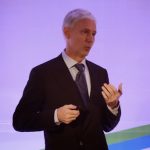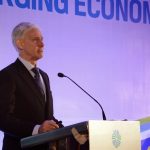- January 24, 2014
- Posted by:
- Category:BLOG, Events, India Investment Conference, Mumbai
Speaker: Richard Duncan, Chief Economist, Blackhorse Asset Management
Moderator: Sandeep Sabharwal, CFA, Senior Director, Capital Markets, CRISIL Research
Written by: Priyank Singhvi, CFA and Jignesh Kamani, CFA, Co-Chair Communication, IAIP and Research Analyst, Nirmal Bang Institutional Equities
In the 19th century business men invested their capital into enterprises, made profits, saved and reinvested their money back into the business and in the process built their capital. Economic growth was driven by investment and savings. Now it is driven by credit creation and consumption. Capitalism has evolved into Creditism and has been Corrupted. With this background Richard Duncan showed how credit has been driving GDP growth since 1980s, why the quarterly credit needs to grow at real rate of 1.8% in the US to just stay out of recession and why he expects QE to stay in the one form or the other in 2014 & 2015.
During gold standard Fed 25% of the reserves were backed by gold. In 1968 the US broke the link between money and gold. With constraints removed total credit or debt has exploded from around $1.0trn to $50trn in 2007 and $58trn currently. The total credit to GDP ratio has increased from 150% in 1964 to 360% in 2012. Richard analyzed this into key sectors viz. households, corporates, federal government, government sponsored enterprises (GSEs) and ABS issuers. He mentioned that government budget deficit was in excess of $1trn / year from 2009 to 2012, driving credit growth which helped US from collapsing. However budget deficit declined to $680bn in 2013 and expected to decline further which would impact credit growth in the US. Based on credit growth in each individual sectors, Richard forecasts total credit growth of 3.2%/3.8%/3.8% for CY13/CY14/CY15 respectively. Assuming inflation of 1.5% for CY13 and 2% for CY14/CY15, he got credit growth after inflation of 1.7%/1.8%/1.8% for CY13/CY14/CY15 respectively which is still below 2%, recession threshold. Another analysis of total credit growth and GDP growth (adjusted for inflation) during 1952-2012 also concluded that every time credit grew by less than 2% it was followed by a recession. In line with these findings, for US to come out of recession, its credit growth has to be more than 2% or $2.3trn in 2014. Total credit growth has turned positive in the past few quarters but total credit growth at $1.84trn is lower than $2.3trn. As a result, Richard believes more QEs is likely to be required.
Richard mentioned that the global economy is like a big rubber raft, but one inflated with credit instead of air. The raft is defective as global debt has expanded to such an extent that the income of the world’s population is insufficient to service it. As the raft is defective and the credit is leaking out through numerous holes as it is destroyed by defaults, so the raft’s natural tendency is to sink. Without more government borrowing, spending and printing, the raft will sink.
Richard also checked possibility of tapper off through liquidity gauge. Liquidity gauge is creation of liquidity (by Fed) less absorption of liquidated (due to current account deficit). Last year $1trn was created by Fed but $700bn was absorbed due to budget deficit, resulting liquidity gauge of $300bn, which resulted into 30% increase in stock market. Based on the Fed’s taper schedule, the liquidity gauge would become negative (liquidity drain) in Q3 2014 onward. The liquidity drain beginning in Q3 2014 would push up interest rates and cause a new recession. Hence, Richard expects the taper schedule to be revised and QE expanded into 2015. Richard expects between $500bn and $1trn of QE both in 2014 and 2015. As per Richard, quantum of liquidity created by Fed will be such that it increases stock market by 10-15% and housing market by 7% so that the wealth effect led economic activity continues.
The US current account deficit (‘CAD’) used to be the driver of global economic growth. Till 1982 US CAD was close to zero, from 1992 it expanded continuously to $800bn in 2006 and drove growth in global economy. US was financing its CAD with fiat money, in form of US$ denominated bonds. As the crisis started US economy started importing less, which impacted global demand. The US CAD continues to show a contracting trend due to various reasons like reduced economic activity, reduced oil imports with discovery of shale gas, etc.
On China Richard mentioned that moderating growth in imports from China, which will reduce growth in China. China has created excess capacities and stock piles that can’t be optimally used, because US and UK are not buying and China can’t consume locally due to low average income. Linked to that, he also shared his concerns on the potential NPA issues in China.
Richard expressed his concerns that the money that is being created is largely used for non-productive purposes and suggested that US needs to explore options to invest money in real economy and programs focused on new technologies like nano tech, etc. Drawing parallels with the Industrial revolution some 200 years ago, he suggested increase in real wages across countries to fix the problems of the global economy. This could be by way of some minimum global wages for manufacturing and increasing the same by small amount every year. This will distribute more money into the hands of common man and lead to growth in consumption.
– J K and P S
PS: Each of speaker sessions and the panel discussion has been covered separately under IIC14. These include:
- The End of Quantitative Easing, the Outlook for Emerging Markets and the Rupee by Prof. Avinash Persaud
- Future of Finance: Key Issues Facing the Finance Industry by Frederic Lebel, CFA
- A Changing Global Energy Landscape – Implications for India by Dr. Fereidun Fesharaki
- Executive Panel Discussion – India Investment Outlook
- The Inaugural Session by Paul Smith,CFA, Jayesh Gandhi, CFA and Dr.Vikram Kuriyan, CFA
- A comprehensive list of photographs could be viewed in the slide show in the note titled: IIC14 – The Road Ahead for India & Emerging Economies


























[…] · Corruption of Capitalism: Challenges to Sustainable Growth & Asset Allocations by Richard Duncan. Kindly follow the link http://iaip.wordpress.com/2014/01/24/iic14-corruption-of-capitalism-challenges-to-sustainable-growth… […]